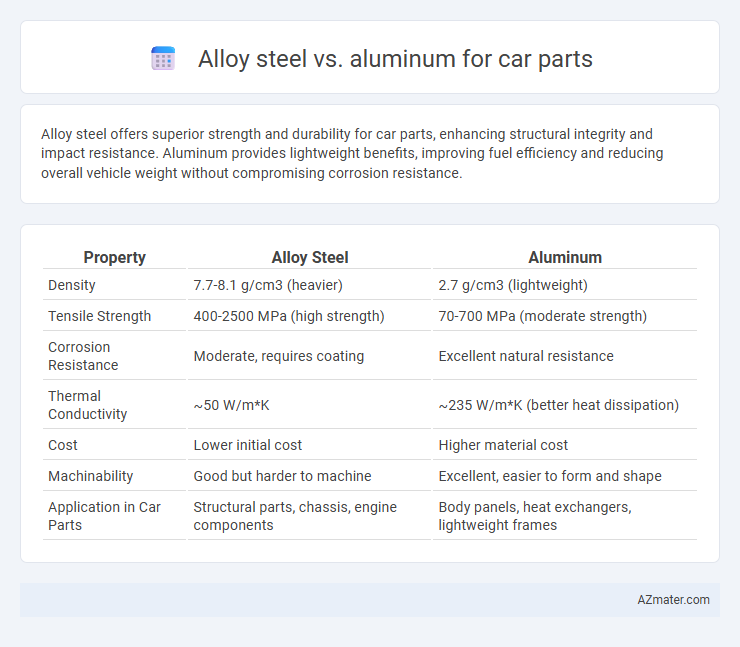Alloy steel offers superior strength and durability for car parts, enhancing structural integrity and impact resistance. Aluminum provides lightweight benefits, improving fuel efficiency and reducing overall vehicle weight without compromising corrosion resistance.
Table of Comparison
| Property | Alloy Steel | Aluminum |
|---|---|---|
| Density | 7.7-8.1 g/cm3 (heavier) | 2.7 g/cm3 (lightweight) |
| Tensile Strength | 400-2500 MPa (high strength) | 70-700 MPa (moderate strength) |
| Corrosion Resistance | Moderate, requires coating | Excellent natural resistance |
| Thermal Conductivity | ~50 W/m*K | ~235 W/m*K (better heat dissipation) |
| Cost | Lower initial cost | Higher material cost |
| Machinability | Good but harder to machine | Excellent, easier to form and shape |
| Application in Car Parts | Structural parts, chassis, engine components | Body panels, heat exchangers, lightweight frames |
Introduction: Alloy Steel vs Aluminum in Automotive Applications
Alloy steel and aluminum are widely used materials in automotive manufacturing, each offering unique advantages for car parts. Alloy steel provides superior strength, durability, and wear resistance, making it ideal for structural components and high-stress areas. Aluminum, with its lightweight properties and excellent corrosion resistance, enhances fuel efficiency and performance in automotive applications such as body panels and engine parts.
Material Properties Comparison
Alloy steel offers superior tensile strength and fatigue resistance compared to aluminum, making it ideal for structural car parts requiring high durability. Aluminum provides excellent corrosion resistance and a significantly lower density, resulting in weight reduction and improved fuel efficiency for automotive components. The choice between alloy steel and aluminum depends on balancing strength requirements with weight savings in car part applications.
Weight and Performance Impact
Alloy steel offers superior strength and wear resistance compared to aluminum, making it ideal for high-stress car parts such as suspension components and drivetrain elements. Aluminum's lower density significantly reduces vehicle weight, enhancing fuel efficiency and handling performance without compromising moderate structural integrity. The choice between alloy steel and aluminum directly affects vehicle weight distribution and overall dynamic performance, with aluminum preferred for lightweight applications and alloy steel favored where durability is critical.
Strength and Durability Factors
Alloy steel offers superior strength and durability compared to aluminum, making it ideal for car parts exposed to high stress and wear, such as suspension components and chassis elements. Its high tensile strength and resistance to fatigue ensure longer service life under demanding conditions, while aluminum, though lighter and corrosion-resistant, typically lacks the same structural robustness for heavy-duty applications. Choosing alloy steel enhances vehicle safety and performance in critical load-bearing parts where durability is paramount.
Corrosion Resistance and Longevity
Alloy steel exhibits superior corrosion resistance compared to aluminum when treated with appropriate coatings, allowing car parts to withstand harsh environmental conditions with less degradation. Aluminum naturally forms a protective oxide layer that provides moderate corrosion resistance, helping reduce weight while maintaining durability. The longevity of alloy steel parts tends to exceed aluminum in high-stress and corrosive environments, although aluminum offers excellent performance in lightweight applications with occasional exposure to corrosive elements.
Cost Analysis: Initial and Lifecycle Expenses
Alloy steel offers lower initial material costs compared to aluminum but typically results in higher lifecycle expenses due to increased weight affecting fuel efficiency. Aluminum's higher upfront cost is offset by its lightweight nature, which enhances fuel economy and reduces emissions over the vehicle's lifespan. Manufacturers must balance initial manufacturing costs with long-term savings in maintenance and fuel consumption when choosing between alloy steel and aluminum for car parts.
Manufacturing and Processing Differences
Alloy steel offers superior strength and durability for car parts, requiring processes such as heat treatment and machining to enhance hardness and wear resistance, whereas aluminum's lighter weight allows for easier casting and extrusion with minimal heat treatment. The manufacturing of alloy steel components often involves energy-intensive forging and cutting operations, while aluminum parts benefit from faster, less energy-demanding processes like stamping and hydroforming. These processing differences directly affect production speed, cost, and performance characteristics in automotive applications.
Safety Considerations in Car Parts
Alloy steel offers superior tensile strength and impact resistance, making it ideal for critical car parts where crash safety is paramount. Aluminum's lightweight properties enhance fuel efficiency but typically require thicker sections or advanced alloys to meet stringent safety standards in structural components. Engineers often balance alloy steel's durability with aluminum's weight savings to optimize both crashworthiness and overall vehicle performance.
Environmental Impact and Sustainability
Alloy steel, known for its strength and durability, often requires high energy consumption and emits more CO2 during production compared to aluminum, which benefits from a lower carbon footprint due to lighter weight and easier recyclability. Aluminum's ability to reduce vehicle weight contributes to improved fuel efficiency and lower greenhouse gas emissions over a car's lifecycle. Choosing aluminum for car parts supports sustainability goals by enabling lighter vehicles that consume less fuel, whereas alloy steel's environmental impact is higher despite its superior mechanical properties.
Best Applications: Choosing the Right Material for Specific Car Parts
Alloy steel excels in high-strength applications such as chassis components, suspension parts, and engine blocks due to its durability and wear resistance. Aluminum is ideal for body panels, engine covers, and wheels because of its lightweight properties and excellent corrosion resistance. Selecting the right material depends on balancing strength requirements, weight reduction goals, and cost considerations for optimal vehicle performance.

Infographic: Alloy steel vs Aluminum for Car part
 azmater.com
azmater.com